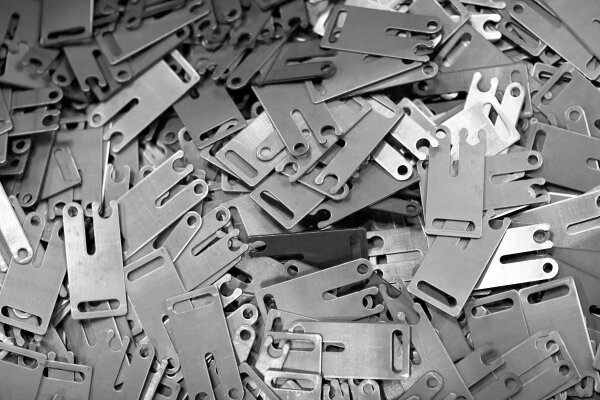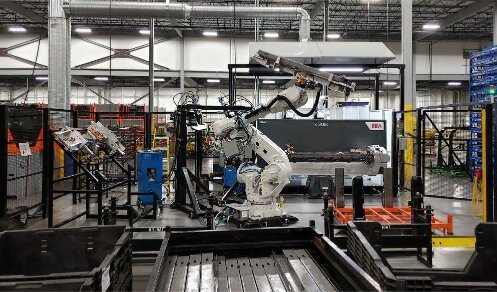La mayoría de la gente no piensa en cómo se fabrican las piezas metálicas de sus productos hasta que las necesita a medida. Es entonces cuando empieza la confusión. Encontrar un taller fiable que ofrezca calidad y rapidez puede resultar abrumador. Es posible que no sepa qué ocurre dentro de un taller de fabricación o qué puede esperar. Pero una vez que entienda cómo funcionan estos talleres, elegir el adecuado será más fácil.
Exploremos lo que ocurre dentro de estos talleres y por qué son cruciales para muchas industrias. Te sorprenderá el impacto que tienen en la vida diaria.

¿Qué es un taller de fabricación de metales?
Un taller de fabricación de metal es un lugar de trabajo que da forma a piezas metálicas. Utiliza técnicas de corte, plegado, soldadura y ensamblaje para convertir chapas o estructuras metálicas en productos finales. Los trabajadores siguen planos técnicos y utilizan herramientas como cortadoras láser, plegadoras y soldadoras MIG.
La mayoría de los talleres toman el diseño de un cliente y se encargan de todo, desde las materias primas hasta los artículos acabados. Su trabajo puede incluir prototipos únicos, pequeños lotes o grandes volúmenes de producción. Se centran en la precisión, la rapidez y la calidad.
Diferencia entre talleres de fabricación y talleres mecánicos
Los talleres de fabricación y los talleres mecánicos trabajan con metal, pero utilizan métodos diferentes.
Los talleres de fabricación dan forma al metal utilizando la fuerza física, como el corte, la soldadura o el doblado. Construyen cosas a partir de chapas, barras y tubos.
Los talleres mecánicos retiran material. Utilizan fresadoras, tornos y rectificadoras CNC para tallar piezas a partir de bloques sólidos.
En términos sencillos, la fabricación aumenta y el mecanizado disminuye. Algunos talleres modernos hacen ambas cosas, pero sus procesos y herramientas principales son diferentes.
Tipos comunes de talleres de fabricación
No todos los talleres de fabricación hacen el mismo trabajo. Cada tipo se especializa en materiales, procesos o sectores distintos. He aquí cómo se desglosan.
Talleres de chapa metálica
Se centran en corte, flexióny la unión de chapas metálicas. Los trabajos típicos incluyen recintos, soportesy armarios.
Talleres de acero estructural
Construyen vigas, columnas y armazones pesados, y sus piezas se utilizan a menudo en edificios, puentes o maquinaria.
Talleres de soldadura
Están especializados en unir piezas metálicas. Algunos talleres sólo hacen soldadura para otros fabricantes.
Tiendas de trabajos a medida
Se encargan de trabajos únicos o puntuales. Estas tiendas trabajan en estrecha colaboración con los clientes para satisfacer necesidades de diseño específicas.
Talleres de fabricación de servicio completo
Estos hacen un poco de todo-diseño, creación de prototipos, corte por láser...soldando, acabadoy asamblea. Gestionan todo el proceso de producción bajo un mismo techo.

Qué hacen los talleres de fabricación?
Los talleres de fabricación transforman las materias primas en piezas funcionales. He aquí cómo lo hacen, paso a paso.
Corte
El corte suele ser el primer paso. Da forma a la materia prima en piezas más pequeñas y utilizables.
Los talleres utilizan herramientas como cortadoras láser, cortadoras de plasma y cizallas, que cortan chapas, tubos o barras de metal con rapidez y precisión.
El corte por láser es estándar para obtener bordes limpios y trabajos detallados. Corte por plasma funciona bien en materiales más gruesos. Las cizallas son mejores para cortes rectos y rápidos.
Conformado y plegado
Tras el corte, a menudo es necesario doblar o dar forma al metal.
Para ello, los talleres utilizan prensas plegadoras y rodillos. La prensa plegadora empuja el metal con fuerza y una matriz. Los rodillos curvan el metal formando arcos o cilindros.
Este paso crea los ángulos, pliegues y curvas del diseño final. Un plegado preciso es clave para que las piezas encajen y funcionen.
Soldadura
La soldadura une dos o más piezas metálicas. Este paso es necesario cuando las piezas no pueden fabricarse a partir de una sola chapa o barra.
Son habituales las soldaduras MIG, TIG y por puntos. Cada una se utiliza de forma diferente en función del tipo de material, el grosor de la pieza y el diseño.
Las buenas soldaduras son fuertes y limpias. Mantienen las piezas unidas al tiempo que cumplen los requisitos visuales y de seguridad.
Mecanizado
Algunas piezas requieren tolerancias estrechas o características detalladas. Ahí es donde entra en juego el mecanizado.
El mecanizado elimina pequeñas cantidades de metal para hacer agujeros, ranuras o superficies lisas. Los talleres de fabricación pueden utilizar taladros, fresadoras o tornos.
Este paso suele utilizarse después de la soldadura o el plegado. Garantiza que la pieza cumpla los requisitos exactos de tamaño y forma.
Asamblea
Una vez cortadas, dobladas, soldadas y mecanizadas, las piezas se ensamblan.
El montaje puede realizarse con tornillos, remaches, pernos o soldaduras. Algunos talleres añaden componentes electrónicos, bisagras o paneles.
Un montaje completo proporciona al cliente un producto o subconjunto listo para usar. Ahorra tiempo y reduce la necesidad de proveedores adicionales.
Acabado
El acabado protege la pieza y mejora su aspecto.
Los comercios pueden polaco, capa de polvopintura o anodizar la superficie. Algunos acabados añaden resistencia a la corrosión. Otros dan un aspecto liso o brillante.
El acabado también incluye el desbarbado y la limpieza para eliminar bordes afilados o suciedad. Este último paso ayuda a cumplir las normas de calidad y las necesidades de los usuarios.
Herramientas y equipos utilizados en los talleres de fabricación
Los talleres de fabricación utilizan equipos especializados para convertir las materias primas en piezas de precisión. He aquí un vistazo a las máquinas clave que lo hacen posible.
Herramientas de corte
Los tipos más comunes son las cortadoras láser, las cortadoras de plasma y los chorros de agua. Las cortadoras láser son precisas y limpias, y las mejores para formas detalladas. Las cortadoras de plasma cortan metales gruesos con rapidez. Los chorros de agua cortan sin calor, por lo que son adecuados para materiales delicados.
Equipos de conformado
Las plegadoras doblan chapas metálicas en ángulos o curvas. Los rodillos dan forma redonda o curva al metal. Estas máquinas utilizan la presión para dar forma al material sin agrietarlo.
Máquinas de soldadura
Las soldadoras MIG, TIG y por puntos son estándar. MIG es rápido y adecuado para trabajos generales. TIG ofrece un mejor control para piezas finas o delicadas. La soldadura por puntos se utiliza a menudo en trabajos de chapa metálica.
Herramientas de mecanizado
Las fresadoras y tornos CNC eliminan material para piezas detalladas o con tolerancias estrechas. Las taladradoras, roscadoras y amoladoras ayudan a acabar superficies o crear orificios.
Herramientas de montaje
Por ejemplo, pistolas remachadoras, llaves dinamométricas, abrazaderas y herramientas manuales. Algunos talleres utilizan fijaciones para sujetar las piezas durante la soldadura o el montaje.
Herramientas de acabado
Las desbarbadoras, lijadoras y pulidoras suavizan los bordes y mejoran la calidad de la superficie. Los sistemas de revestimiento, como las cabinas de pintura en polvo o las pistolas de pintura, añaden capas protectoras.

¿Qué se fabrica en los talleres?
Los talleres de fabricación producen innumerables artículos que utilizamos a diario. Examinemos las categorías de productos más comunes.
Componentes estructurales para la construcción
Constituyen el esqueleto de los edificios y las infraestructuras:
- Vigas de acero en I para rascacielos
- Cerchas de soporte de puentes
- Escaleras y barandillas
- Bastidores de plataformas industriales
Cajas y armarios para electrónica
La carcasa metálica de precisión protege los equipos sensibles:
- Bastidores de servidores para centros de datos
- Cuadros eléctricos
- Carcasas para dispositivos médicos
- Marquesinas para equipos de telecomunicaciones
Piezas automotrices y aeroespaciales
Componentes duraderos y ligeros para vehículos:
- Bastidores y soportes de chasis
- Componentes del sistema de escape
- Paneles interiores de aeronaves
- Piezas del compartimento del motor
Prototipos personalizados y series pequeñas
Soluciones especializadas para necesidades únicas:
- Piezas únicas de máquinas
- Desarrollo de prototipos de productos
- Componentes de repuesto para equipos heredados
- Tiradas limitadas
¿Cómo funcionan los talleres de fabricación?
Los talleres de fabricación siguen un flujo de trabajo preciso para garantizar la calidad y la eficacia. Este es el proceso típico paso a paso.
Presupuestos y revisión del diseño
El proceso comienza cuando un cliente envía un dibujo o un modelo en 3D. El taller revisa el diseño para comprobar la viabilidad y el uso de materiales.
A continuación, preparan un presupuesto, que incluye el coste, el plazo de entrega y los pasos del proceso. Los talleres pueden sugerir cambios para mejorar la función o reducir el coste.
Ingeniería y planificación de materiales
Una vez aprobado el pedido, el equipo de ingeniería prepara archivos detallados que guían a las máquinas y los operarios en las operaciones de corte, plegado y soldadura.
Al mismo tiempo, el taller encarga las materias primas y programa el trabajo. Este paso garantiza que todo esté listo cuando empiece la producción.
Fabricación y controles de calidad
Ahora, el taller empieza a cortar, conformar, soldar y mecanizar. Los trabajadores siguen al pie de la letra los planos. Las máquinas se ajustan con valores exactos de tamaño y forma.
En cada paso se realizan controles de calidad. Los técnicos inspeccionan las medidas, las soldaduras y el acabado superficial para evitar que los errores progresen.
Embalaje y entrega
Cuando la pieza está terminada y aprobada, pasa al embalaje. La tienda protege el artículo con espuma, envoltorios de plástico o cajas.
Las piezas se etiquetan, cargan y envían siguiendo las instrucciones del cliente. Algunas tiendas ofrecen entrega local, mientras que otras realizan envíos a todo el mundo.

La gente detrás del metal
Todo taller de fabricación depende de la colaboración de profesionales cualificados. A continuación le indicamos quién hace qué para que sus piezas se fabriquen correctamente.
Soldadores, fabricantes y maquinistas
Estos expertos prácticos trabajan directamente con los materiales:
- Soldadores unir metales utilizando diversas técnicas (MIG, TIG, varilla)
- Fabricantes manejar prensas plegadoras, rodillos y máquinas de corte
- Maquinistas realizar operaciones de taladrado, fresado y acabado
- Todos siguen instrucciones de trabajo y planos detallados
Ingenieros y diseñadores
Los solucionadores de problemas técnicos:
- Ingenieros de diseño convertir conceptos en diseños fabricables
- Ingenieros de procesos determinar los mejores métodos de fabricación
- Técnicos CAD crear modelos digitales detallados
- Especialistas en nidificación optimizar el uso del material
Inspectores de calidad y gestores de proyectos
Los guardianes de la calidad y los plazos:
- Inspectores verificar las dimensiones utilizando calibradores, MMC y calibres
- Responsables de control de calidad mantener las normas ISO y otras normas de calidad
- Jefes de proyecto coordinar el flujo de trabajo y los plazos
- Responsables de seguridad garantizar el cumplimiento de la normativa OSHA
Personal de la cadena de suministro y logística
Los organizadores entre bastidores:
- Agentes de compras obtener materias primas a los mejores precios
- Gestores de inventario controlar los niveles de existencias
- Coordinadores de envíos organizar entregas puntuales
- Personal de atención al cliente gestionar las actualizaciones de los pedidos y las consultas
¿Cómo elegir el taller de fabricación adecuado?
Elegir el taller de fabricación adecuado influye en el coste, el plazo de entrega y la calidad del producto. Un buen taller se adapta a sus necesidades técnicas y trabaja como un socio, no como un simple proveedor. Estos son los aspectos clave que debe comprobar antes de comprometerse.
Experiencia y certificaciones
Empiece por su trayectoria. ¿Cuánto tiempo llevan en el negocio? ¿Tienen experiencia con su tipo de pieza o sector?
Certificaciones como ISO 9001, AWS o AS9100 demuestran que el taller sigue estrictos sistemas de calidad. Esto es más importante en sectores como el aeroespacial o el médico.
Busque un equipo que entienda tanto de diseño como de producción. Así evitará errores y mejorará su producto.
Equipamiento y capacidades
Asegúrese de que el taller dispone de las máquinas adecuadas para su trabajo. No todos los talleres pueden trabajar con chapas gruesas, cortes finos o tolerancias estrechas.
Pregunte por sus cortadoras láser, prensas plegadoras, máquinas CNC y herramientas de acabado. Cuantos más servicios gestionen internamente, más rápido y fluido será su proyecto.
Compruebe si son escalables. Si su prototipo se convierte en un gran pedido, querrá que puedan seguirle el ritmo.
Plazos y comunicación
Un servicio rápido sólo funciona si la tienda se mantiene en contacto. Pregunte cuánto tardan los presupuestos. Averigüe si le informan una vez iniciado el trabajo.
Tiendas que responden con rapidez y con las que es más fácil trabajar. También es más probable que solucionen los problemas pronto, no después de la entrega.
Un taller sólido equilibra la rapidez con la precisión. No se precipitan en detrimento de la calidad.
Cartera y comentarios de los clientes
Pida fotos o muestras de trabajos anteriores. Esto le dará una idea de la gama y la calidad de acabado del artista.
Consulte opiniones en Internet o pida referencias. Las buenas tiendas tienen clientes que repiten y opiniones positivas.
El servicio al cliente, la atención al detalle y la fiabilidad de la entrega son tan importantes como sus máquinas.
Conclusión
En un taller de fabricación, el metal en bruto se convierte en productos reales. Se encarga de cortar, doblar, soldar, mecanizar y ensamblar, todo bajo un mismo techo. Estos talleres están al servicio de sectores como la construcción, la electrónica, la automoción y el aeroespacial.
Cada taller cuenta con equipos cualificados, potentes herramientas y flujos de trabajo paso a paso. Desde el presupuesto hasta la entrega, cada paso se centra en la precisión, la rapidez y las necesidades del cliente.
¿Necesita piezas metálicas rápidas y correctas? Envíenos sus dibujos o ideas-Los revisaremos y le enviaremos un presupuesto preciso en un plazo breve. Sin conjeturas. Sólo respuestas directas y resultados de calidad.
Hola, soy Kevin Lee

Durante los últimos 10 años, he estado inmerso en diversas formas de fabricación de chapa metálica, compartiendo aquí ideas interesantes de mis experiencias en diversos talleres.
Póngase en contacto

Kevin Lee
Tengo más de diez años de experiencia profesional en la fabricación de chapas metálicas, especializada en corte por láser, plegado, soldadura y técnicas de tratamiento de superficies. Como Director Técnico de Shengen, me comprometo a resolver complejos retos de fabricación y a impulsar la innovación y la calidad en cada proyecto.




